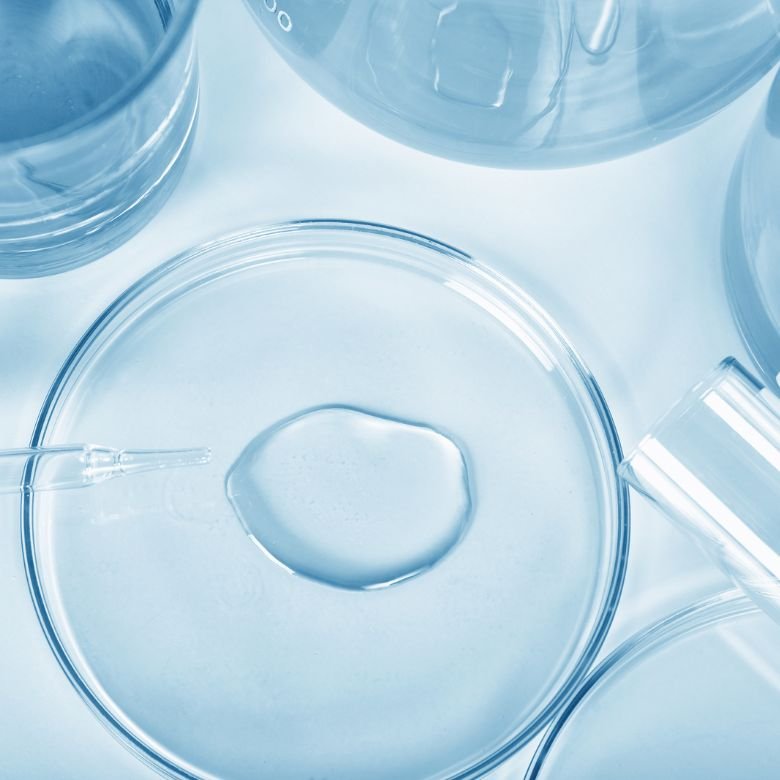Colloidal systems are physically and chemically heterogeneous mixtures. These are dispersion systems, usually two-component, with the appearance of physically homogeneous systems, although in fact both components are not molecularly mixed with each other. The term ‘colloidal’ refers to an order of magnitude particle dispersed in a certain medium that has a diameter dimension of approximately between 1 and 100 nm. These are, for example, solutions of substances such as peptides, proteins, amylum and synthetic polymers.

The surface area of the contacting phases may be macroscopic. The thickness of the inter-facial surface is about 0.5-2 nm, therefore the colloidal particle must be at least twice the thickness of the surface layer. Hence, the lower limit of the size of a colloidal particle is 1 nm, the upper limit is 100 nm. Colloidal particles can be three-dimensional if all dimensions are of the order of colloidal fineness, two-dimensional (lamellar) where two dimensions are of this order, or one-dimensional (threadlike) when one dimension is of colloidal fineness.
Dispersion system
It is a system containing a dispersing medium and a dispersed substance. We can divide it into several types:
- if the dispersed substance is a set of particles of the same size – it is monodisperse,
- when the particles of the dispersed substance have different sizes – it is polydisperse,
- the particles of the dispersed substance have the same shape (e.g. rods, balls, lamellae) – monomorphic,
- if the particles of the dispersed substance have different shapes – multiform.
Colloid systems
The dispersed (dispersion) phase is present in a small amount compared to the amount of the second phase, which constitutes the continuous dispersion medium. The continuous phase (e.g. solvent) is called the dispersion medium. The dispersed phase is formed by the second component. Colloidal particles are contained between systems with molecular fragmentation (e.g. solutions) or mechanical fragmentation (suspensions). Both the dispersed and dispersing phases can exist in any states of aggregation. One of the basic conditions for the stabilization of most colloidal systems is the electric charge of the particles of the dispersed phase. On the surface of each particle there is a so-called electrical layer, i.e.:
- the stationary layer made of strongly adsorbed ions and dipoles, directly on the surface of the colloidal particle,
- the diffusion layer in which ions and dipoles are arranged in a certain way, but are located at a certain distance from the surface of the particles, are less bound to it and can change their position.
As a result of such arrangement of ions and dipoles, a potential difference is created at the interface between the colloidal particle and the dispersion medium. The neutralization of the electric charges of the colloids often leads to the destruction of the colloid state by the separation of the dispersed phase in the form of larger clusters, which is called coagulation.
Obtaining colloids
Many substances can be converted into a state of colloidal fragmentation by using an appropriate dispersion medium, temperature and work technique. It can be obtained in the process of dispersion (fragmentation) of macroscopic systems or in the process of condensation of atoms, ions or molecules into aggregates (aggregated particles) of specific sizes. The basic methods are divided into dispersion and condensation methods.
- Dispersion methods: mechanical grinding (grinding), electric dispersion, ultrasonic atomization, thermal atomization, colloidal dissolution, peptization process. Fragmentation is a work against cohesive forces.
The selection of the method depends on the state of aggregation of the dispersing medium and the dispersed substance. In the case of macromolecular substances, it is enough to dissolve the substance in a suitable solvent (e.g. polystyrene in benzene). If the dispersion medium is an organic liquid, grinding should be carried out with the addition of higher organic acids.
- In condensation processes, atoms, ions or particles are formed into aggregates of larger sizes. Condensation in solutions is associated with the course of chemical reactions or with a specific physical phenomenon, and these are usually methods consisting in reducing solubility, reduction, oxidation, exchange reactions, polymerization, hydrolysis. In a chemical reaction, particles are formed by metallic, ionic or covalent bonding, and in physical processes, by intermolecular forces.
An example is the reduction reaction of solutions of noble metal salts, in which hydrosols of these metals are obtained. Reducing agents may be hydrogen peroxide, formaldehyde, hydrazine and ferric salts. The hydrazoles of gold, silver and platinum were obtained by chemical reduction. Separated metal atoms combine into clusters of atoms with colloidal sizes.

Colloid division
- Taking into consideration the way it goes into a colloidal state:
- associative – spontaneously transforming into a colloidal state,
- dispersion – created by forced fragmentation of the dispersed substance.
- Taking into consideration the state of matter:
- aerosols – the dispersing medium is gas; for example: fog, dust,
- sols, colloidal solutions – the dispersion medium is a liquid, for example: foam, milk,
- pyrosols – the dispersing medium is a solid; for example pumice, phosphor pearls.
- Taking into consideration the morphology:
- isometric, where all three dimensions (length, width, height) are equal; for example: balls, cubes,
- anisometric, where the dimensions differ from each other; for example, rods, plates.
- Taking into consideration the affinity of the colloidal particles to the solvent:
- lyophilic – have a high affinity to the solvent, high durability,
- lyophobic – have a low affinity to the solvent.
Examples of colloids
Emulsions – colloidal systems in which both the dispersion medium and the dispersed substance are in a liquid state. The liquids do not mix with each other, but one is dispersed in the other in the form of tiny droplets. Typically, water is one phase and the other is the so-called oil phase. Taking into consideration the structure and volume ratios of the phases, emulsions can be divided into a water-in-oil w/o system, where the dispersing phase is oil, and the dispersed phase is water and, analogously, oil-in-water o/w.
Aerosols are obtained by dispersing a solid (fume) or liquid (mist) in a gas. Smoke is the result of fragmentation of solids in gas, also as a result of a chemical reaction, e.g. NH3 + HCl -> NH4Cl. Mists are the result of the condensation of liquids in supersaturated vapours. Example particle sizes 10 – 1000 Å (Angstrom), e.g. tobacco smoke 2 – 10 Å, drops in clouds 40 – 100 Å.
Foams are obtained by dispersing a gaseous substance in a liquid. The gas particles are separated by thin layers of liquid, which form the foam skeleton. Durability depends on the reinforcement of the membranes separating the gas particles with thin films of surfactants. The formation of foams, the size of dispersed gas particles and their durability are of great importance in the ore enrichment process – flotation. Surfactants added to the water suspension of finely ground ore form fine particles of foam with the injected air, which, interacting selectively with the ore, separate it from the gangue (waste rock).
